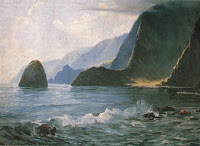I have written about our nearest neighbors, (2/11/15) and when Ned knew I was going to Hawaii
DAVID HOWARD HITCHCOCK was born May 15, 1861 in Hilo, Hawaii. Since his father was also named David Howard Hitchcock (1831–1899), he generally went by D. Howard Hitchcock. His mother was Almeda Eliza Widger (1828–1895). His paternal grandparents were missionaries Harvey Rexford Hitchcock (1800–1855) and Rebecca Howard (1808–1890). His father was a lawyer who served in the legislature of the Hawaiian Kingdom, and his sister Almeda Eliza Hitchcock Moore (1863–1895) was the first woman lawyer in Hawaii Mary Tenney Castle , daughter of Castle & Cooke founder, Samuel Northrup Castle.
After graduating from Punahou School on Oahu, Hitchcock attended Oberlin College in Ohio, where he saw his first art exhibition. Back in Hawaii Hawaii Paris and returned to Hawaii
 |
| Punalu'u |
In 1894, Hitchcock became one of the founders of the Kilohana Art League, an active art program in Honolulu at the turn of the century, exhibiting at least twice a year. He married Hester Judd Dickson (1865-1921) on June 16, 1898 at the Cathedral Church of Saint Andrew, Honolulu. Her maternal grandfather was Gerrit Parmele Judd (1803-73), an early missionary physician to Hawaii
During extensive travels in the 1900s, Hitchcock explored the volcanic regions of the island of Hawaiʻi, and in July 1907 he made his first visit to the island of Kauaʻi, where he painted Waimea Canyon. He toured and painted the island of Maui in 1915 and 1916. He was a leading member of Hawaii 's Volcano School, and his most important paintings date from about 1905 to 1930.
 |
| Pali gap from Kaneolu Bay, Oahu |
His paintings were exhibited at the Alaska-Yukon-Pacific Exposition in Seattle in 1909 (where he was awarded a prize) and at the Panama-Pacific International Exposition in San Francisco in 1915. In 1927, he exhibited several paintings at the opening of the Honolulu Museum of Art, where he had a retrospective exhibition in 1936. In 1939 he exhibited in the Golden Gate International Exposition in San Francisco and at the 1939 New York World's Fair.
Hitchcock died in Honolulu on January 1, 1943 after personally witnessing the Attack on Pearl Harbor in 1941. He had three children.
In 1966 his son Harvey donated a painting of the volcano goddess Pele which was displayed in the Hawaii Volcanoes National Park visitors center. The Bishop Museum (Honolulu), The Boston Museum, the Honolulu Museum of Art, the Isaacs Art Center (Waimea, Hawaii), and the Oakland Museum of California are among the public collections holding paintings by him.
The auction record for a painting by David Howard Hitchcock is $82,250. This record was set by Windward Oahu, Hawaii, a 12 by 18 inch oil painting on canvas sold May 19, 2006. His lovely colors brought back the old Hawaii for me...
The auction record for a painting by David Howard Hitchcock is $82,250. This record was set by Windward Oahu, Hawaii, a 12 by 18 inch oil painting on canvas sold May 19, 2006. His lovely colors brought back the old Hawaii for me...
 |
| Under the Cliffs of Molokai |
 |
| Waimanalo Beach. Oahu |


